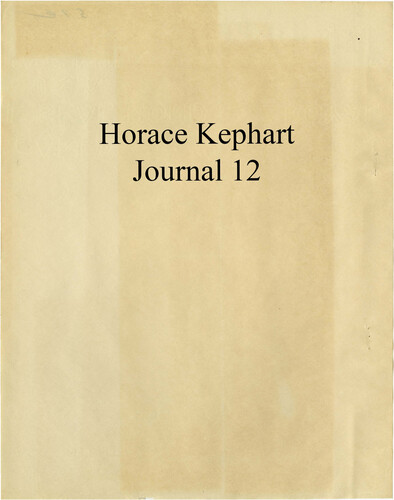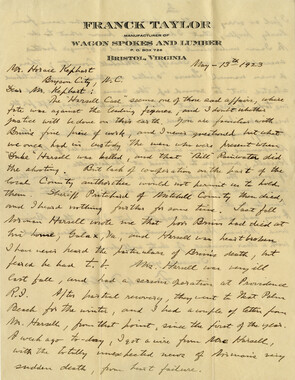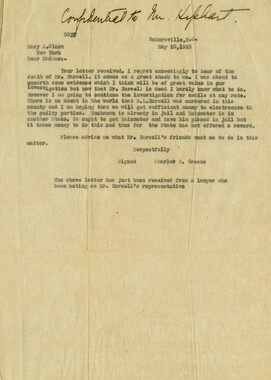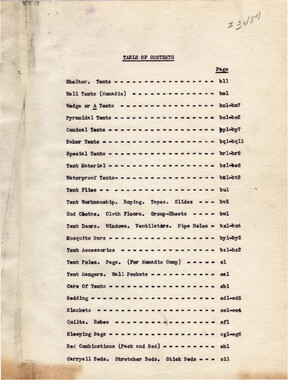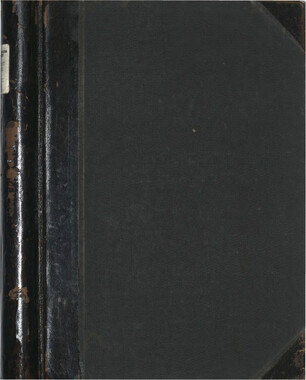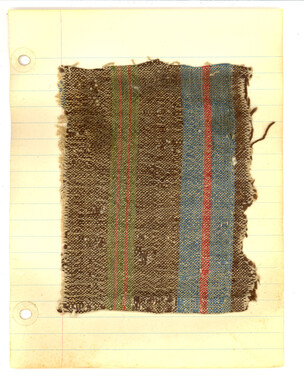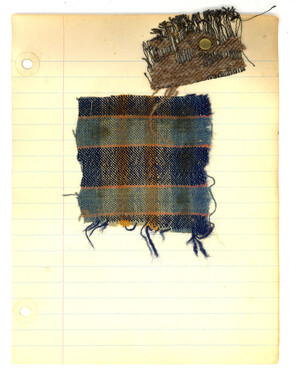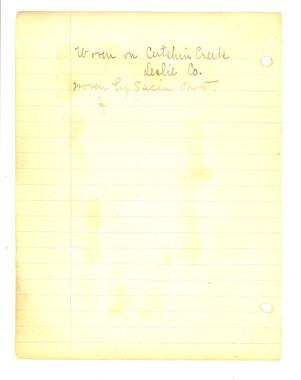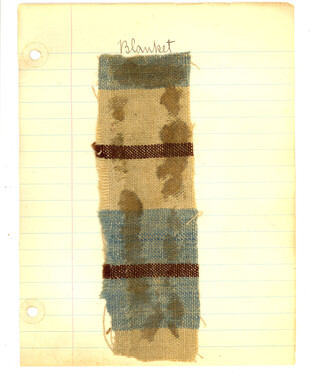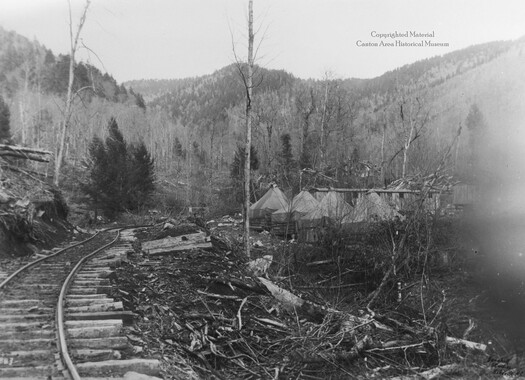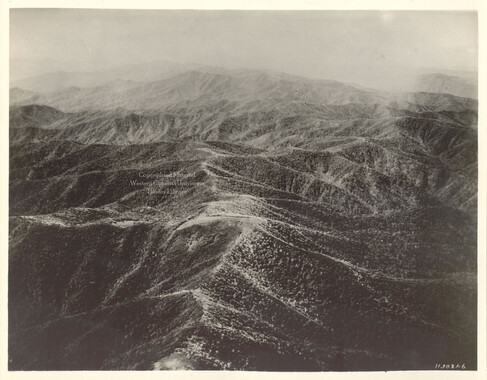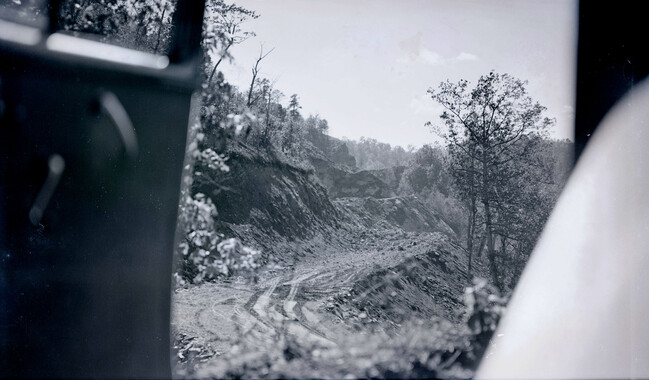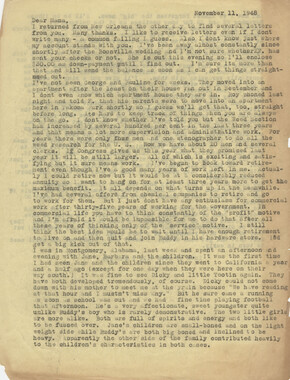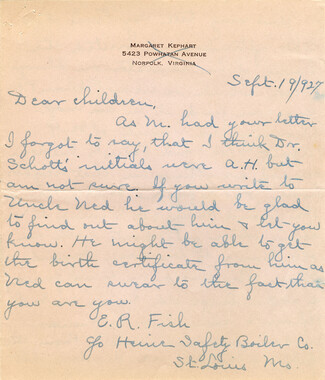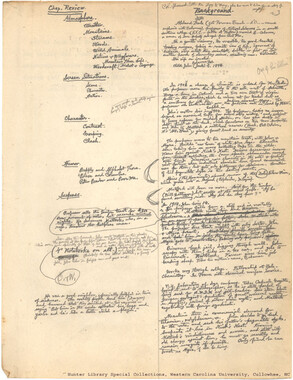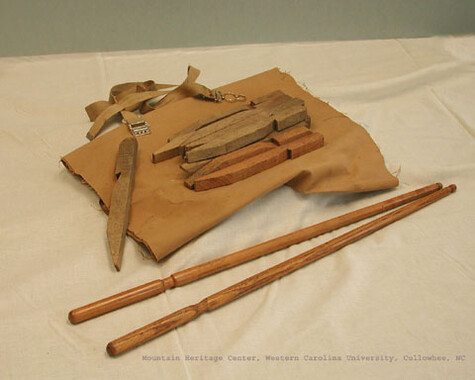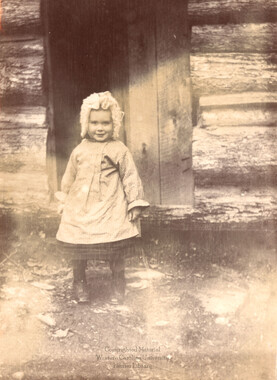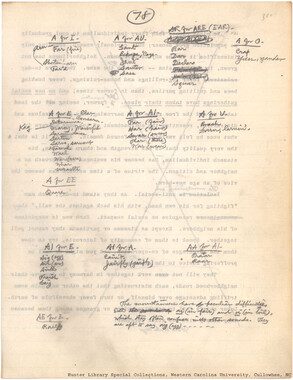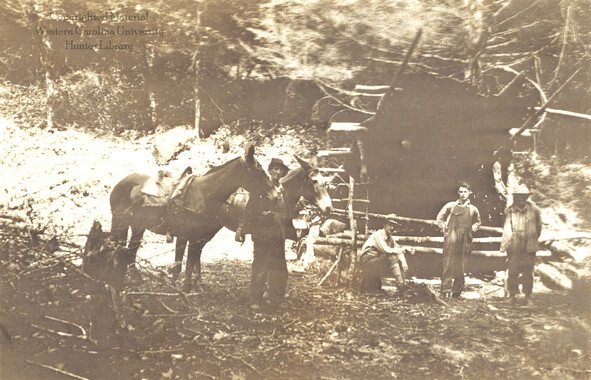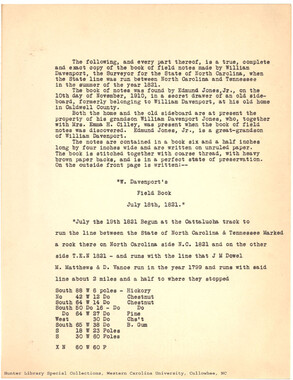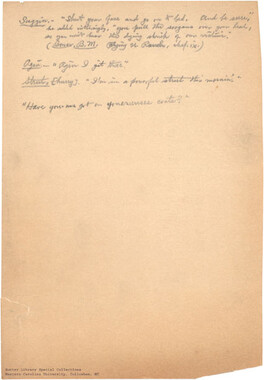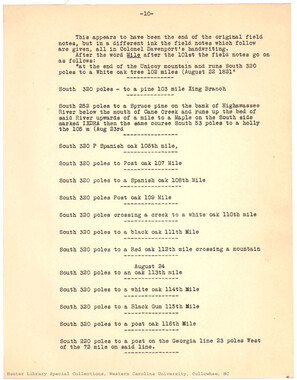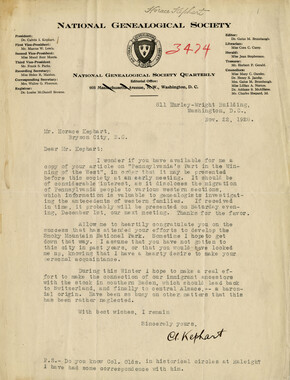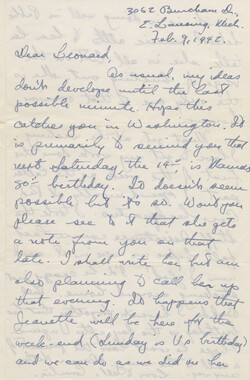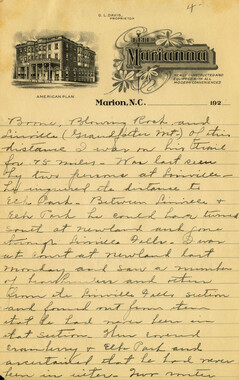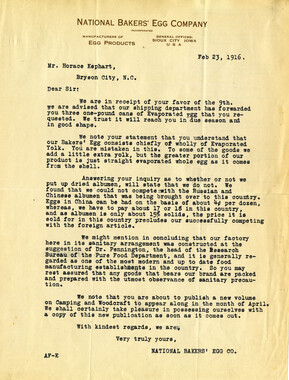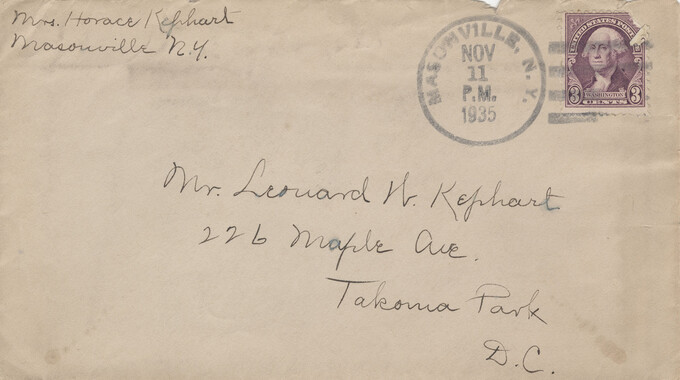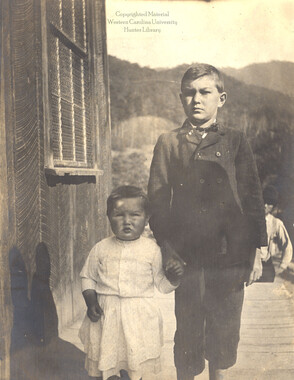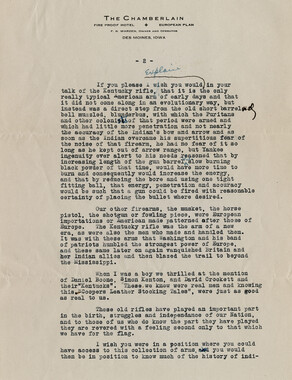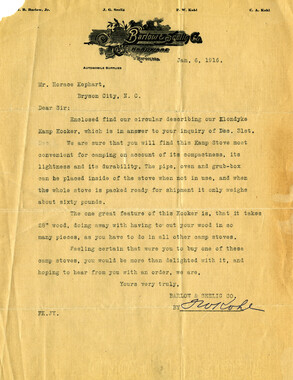Western Carolina University (20)
View all
- Canton Champion Fibre Company (2308)
- Cherokee Traditions (293)
- Civil War in Southern Appalachia (165)
- Craft Revival (1942)
- Great Smoky Mountains - A Park for America (2767)
- Highlights from Western Carolina University (430)
- Horace Kephart (941)
- Journeys Through Jackson (154)
- LGBTQIA+ Archive of Jackson County (19)
- Oral Histories of Western North Carolina (314)
- Picturing Appalachia (6679)
- Stories of Mountain Folk (413)
- Travel Western North Carolina (160)
- Western Carolina University Fine Art Museum Vitreograph Collection (129)
- Western Carolina University Herbarium (92)
- Western Carolina University: Making Memories (708)
- Western Carolina University Publications (2283)
- Western Carolina University Restricted Electronic Theses and Dissertations (146)
- Western North Carolina Regional Maps (71)
- World War II in Southern Appalachia (131)
University of North Carolina Asheville (6)
View all
- Allanstand Cottage Industries (62)
- Appalachian National Park Association (53)
- Bennett, Kelly, 1890-1974 (1295)
- Berry, Walter (76)
- Brasstown Carvers (40)
- Carver, George Washington, 1864?-1943 (26)
- Cathey, Joseph, 1803-1874 (1)
- Champion Fibre Company (233)
- Champion Paper and Fibre Company (297)
- Cherokee Indian Fair Association (16)
- Cherokee Language Program (22)
- Crowe, Amanda (40)
- Edmonston, Thomas Benton, 1842-1907 (7)
- Ensley, A. L. (Abraham Lincoln), 1865-1948 (275)
- Fromer, Irving Rhodes, 1913-1994 (70)
- George Butz (BFS 1907) (46)
- Goodrich, Frances Louisa (120)
- Grant, George Alexander, 1891-1964 (96)
- Heard, Marian Gladys (60)
- Kephart, Calvin, 1883-1969 (15)
- Kephart, Horace, 1862-1931 (313)
- Kephart, Laura, 1862-1954 (39)
- Laney, Gideon Thomas, 1889-1976 (439)
- Masa, George, 1881-1933 (61)
- McElhinney, William Julian, 1896-1953 (44)
- Niggli, Josephina, 1910-1983 (10)
- North Carolina Park Commission (105)
- Osborne, Kezia Stradley (9)
- Owens, Samuel Robert, 1918-1995 (11)
- Penland Weavers and Potters (36)
- Roberts, Vivienne (15)
- Roth, Albert, 1890-1974 (142)
- Schenck, Carl Alwin, 1868-1955 (1)
- Sherrill's Photography Studio (2565)
- Southern Highland Handicraft Guild (127)
- Southern Highlanders, Inc. (71)
- Stalcup, Jesse Bryson (46)
- Stearns, I. K. (213)
- Thompson, James Edward, 1880-1976 (226)
- United States. Indian Arts and Crafts Board (130)
- USFS (683)
- Vance, Zebulon Baird, 1830-1894 (1)
- Weaver, Zebulon, 1872-1948 (58)
- Western Carolina College (230)
- Western Carolina Teachers College (282)
- Western Carolina University (1794)
- Western Carolina University. Mountain Heritage Center (18)
- Whitman, Walt, 1819-1892 (10)
- Wilburn, Hiram Coleman, 1880-1967 (73)
- Williams, Isadora (3)
- Cain, Doreyl Ammons (0)
- Crittenden, Lorraine (0)
- Rhodes, Judy (0)
- Smith, Edward Clark (0)
- Appalachian Region, Southern (2393)
- Asheville (N.C.) (1886)
- Avery County (N.C.) (26)
- Blount County (Tenn.) (161)
- Buncombe County (N.C.) (1664)
- Cherokee County (N.C.) (283)
- Clay County (N.C.) (555)
- Graham County (N.C.) (233)
- Great Smoky Mountains National Park (N.C. and Tenn.) (478)
- Haywood County (N.C.) (3522)
- Henderson County (N.C.) (70)
- Jackson County (N.C.) (4692)
- Knox County (Tenn.) (25)
- Knoxville (Tenn.) (12)
- Lake Santeetlah (N.C.) (10)
- Macon County (N.C.) (420)
- Madison County (N.C.) (211)
- McDowell County (N.C.) (39)
- Mitchell County (N.C.) (132)
- Polk County (N.C.) (35)
- Qualla Boundary (981)
- Rutherford County (N.C.) (76)
- Swain County (N.C.) (2020)
- Transylvania County (N.C.) (247)
- Watauga County (N.C.) (12)
- Waynesville (N.C.) (68)
- Yancey County (N.C.) (72)
- Aerial Photographs (3)
- Aerial Views (60)
- Albums (books) (4)
- Articles (1)
- Artifacts (object Genre) (228)
- Biography (general Genre) (2)
- Cards (information Artifacts) (38)
- Clippings (information Artifacts) (191)
- Crafts (art Genres) (622)
- Depictions (visual Works) (21)
- Design Drawings (1)
- Drawings (visual Works) (184)
- Envelopes (73)
- Facsimiles (reproductions) (1)
- Fiction (general Genre) (4)
- Financial Records (12)
- Fliers (printed Matter) (67)
- Glass Plate Negatives (381)
- Guidebooks (2)
- Internegatives (10)
- Interviews (811)
- Land Surveys (102)
- Letters (correspondence) (1013)
- Manuscripts (documents) (619)
- Maps (documents) (159)
- Memorandums (25)
- Minutes (administrative Records) (59)
- Negatives (photographs) (5735)
- Newsletters (1285)
- Newspapers (2)
- Occupation Currency (1)
- Paintings (visual Works) (1)
- Pen And Ink Drawings (1)
- Periodicals (193)
- Personal Narratives (7)
- Photographs (12982)
- Plans (maps) (1)
- Poetry (5)
- Portraits (1657)
- Postcards (329)
- Programs (documents) (151)
- Publications (documents) (2237)
- Questionnaires (65)
- Scrapbooks (282)
- Sheet Music (1)
- Slides (photographs) (402)
- Sound Recordings (796)
- Specimens (92)
- Speeches (documents) (15)
- Tintypes (photographs) (8)
- Transcripts (322)
- Video Recordings (physical Artifacts) (23)
- Vitreographs (129)
- Text Messages (0)
- A.L. Ensley Collection (275)
- Appalachian Industrial School Records (7)
- Appalachian National Park Association Records (336)
- Axley-Meroney Collection (2)
- Bayard Wootten Photograph Collection (20)
- Bethel Rural Community Organization Collection (7)
- Blumer Collection (5)
- C.W. Slagle Collection (20)
- Canton Area Historical Museum (2110)
- Carlos C. Campbell Collection (282)
- Cataloochee History Project (65)
- Cherokee Studies Collection (4)
- Daisy Dame Photograph Album (5)
- Daniel Boone VI Collection (1)
- Doris Ulmann Photograph Collection (112)
- Elizabeth H. Lasley Collection (1)
- Elizabeth Woolworth Szold Fleharty Collection (4)
- Frank Fry Collection (95)
- George Masa Collection (173)
- Gideon Laney Collection (452)
- Hazel Scarborough Collection (2)
- Hiram C. Wilburn Papers (28)
- Historic Photographs Collection (236)
- Horace Kephart Collection (861)
- Humbard Collection (33)
- Hunter and Weaver Families Collection (1)
- I. D. Blumenthal Collection (4)
- Isadora Williams Collection (4)
- Jesse Bryson Stalcup Collection (47)
- Jim Thompson Collection (224)
- John B. Battle Collection (7)
- John C. Campbell Folk School Records (80)
- John Parris Collection (6)
- Judaculla Rock project (2)
- Kelly Bennett Collection (1314)
- Love Family Papers (11)
- Major Wiley Parris Civil War Letters (3)
- Map Collection (12)
- McFee-Misemer Civil War Letters (34)
- Mountain Heritage Center Collection (4)
- Norburn - Robertson - Thomson Families Collection (44)
- Pauline Hood Collection (7)
- Pre-Guild Collection (2)
- Qualla Arts and Crafts Mutual Collection (12)
- R.A. Romanes Collection (681)
- Rosser H. Taylor Collection (1)
- Samuel Robert Owens Collection (94)
- Sara Madison Collection (144)
- Sherrill Studio Photo Collection (2558)
- Smoky Mountains Hiking Club Collection (616)
- Stories of Mountain Folk - Radio Programs (374)
- The Reporter, Western Carolina University (510)
- Venoy and Elizabeth Reed Collection (16)
- WCU Gender and Sexuality Oral History Project (32)
- WCU Mountain Heritage Center Oral Histories (25)
- WCU Oral History Collection - Mountain People, Mountain Lives (71)
- WCU Students Newspapers Collection (1744)
- Western North Carolina Tomorrow Black Oral History Project (69)
- William Williams Stringfield Collection (2)
- Zebulon Weaver Collection (109)
- African Americans (388)
- Appalachian Trail (35)
- Artisans (521)
- Cherokee art (84)
- Cherokee artists -- North Carolina (10)
- Cherokee language (21)
- Cherokee pottery (101)
- Cherokee women (208)
- Church buildings (166)
- Civilian Conservation Corps (U.S.) (110)
- College student newspapers and periodicals (1830)
- Dams (95)
- Dance (1023)
- Education (222)
- Floods (60)
- Folk music (1015)
- Forced removal, 1813-1903 (2)
- Forest conservation (220)
- Forests and forestry (917)
- Gender nonconformity (4)
- Great Smoky Mountains National Park (N.C. and Tenn.) (154)
- Hunting (38)
- Landscape photography (10)
- Logging (103)
- Maps (84)
- Mines and mineral resources (8)
- North Carolina -- Maps (18)
- Paper industry (38)
- Postcards (255)
- Pottery (135)
- Railroad trains (69)
- Rural electrification -- North Carolina, Western (3)
- School integration -- Southern States (2)
- Segregation -- North Carolina, Western (5)
- Slavery (5)
- Sports (452)
- Storytelling (245)
- Waterfalls -- Great Smoky Mountains (N.C. and Tenn.) (66)
- Weaving -- Appalachian Region, Southern (280)
- Wood-carving -- Appalachian Region, Southern (328)
- World War, 1939-1945 (173)
Horace Kephart Journal 12
-
Horace Kephart (1862-1931) was a noted naturalist, woodsman, journalist, and author. In 1904, he left St. Louis and permanently moved to western North Carolina. Living and working in a cabin on Hazel Creek in Swain County, Kephart began to document life in the Great Smoky Mountains. He created 27 journals in which he made copious notes on a variety of topics. Journal 12 (previously known as Journal XV) includes information on criminology, laws, and judges. Click the link in the Related Materials field to view a table of contents for this journal.
-
-
Horace Kephart Joumal12 () CRilfiNOLOGY • . Edwards, Albert. A Man;s World. 12mo, $1.25a; postpaid, $1.37. (')·, , ·~'('(. ·/ It is amid the tears and laughter, the poverty, the crimes and passions of the New York underworld that Mr. E dwards unfo lds this highly interesting drama , of an active life. He has written with amazing strength and absolute frankn ess, producit1g a timely novel of New York City life. A Man's World Beginning with the boyhood of Arnold Whitman, A Man's World relates the chief incidents in his life. Brought up under the restrictions of the seventies, in t~ home of his uncle, a Presbyterian minister, Ar-he cannot in justice to himself accept, quarrels with . nold rebels against certain forms of religion which I his guardian in the middle of his college career, is deprived of all funds and forced to support himself. After a brief experience as a librarian in New York, which ends in temporary blindness, he becomes a sort of probation officer in connection with the Tombs in New York City, and eventually a criminologist. During his blindness, however, he has met Ann, the daughter of an anarchist, a believer in free love and a very remarkable person. Her influ-ence upon Arnold and her relation to him are among the most unusual passages in the ·novel. While connected with the Tombs, Arnold forms a close friend-ship with an eccentric but noble social up-lifter, Nor-man Benson, and the two after being expelled from a settlement house live together in the slums, now engaged actively in some cause of reform and often discussing problems of poverty, crime and education. It is in this part of his life that Nina, the real hero-ine, perhaps, if a book that is so sure a picture of life as this, may be said to have a heroine, comes. A woman of the streets of the worst type, absolutely void of a sense of right and wrong, a creature whose conscience seems unborn, she is as amazing a figure as has entered modern fiction in some time. The trend of the book is entirely altered by her appearance and what Mr. Edwards does with her and means to show through her, makes as absorbing reading as it is full of suggestion. The Novel and the New York Police It is a peculiar thing-possibly it is significantthat this novel, written long before the investigations into police conditions in New York City were started, should touch, and totich surely, upon one phase of that organization. There is no doubt that many of the incidents surrounding Nina, particularly the struggle to rescue her from the clutches of a political club, have their parallel in the actual lives of women of Nina's class in New York City. God~ar~, ~en~y Herbert. !The KalJikak Family n tu Y 111 Heredity and Feeble-Minded~ - ess. Ill., 8vo, $1.50a ; postpaid, $1.62. ( ~J.D,:"'-. -- The Kallikak Family _It is quite a diff~rent problem which Dr. Goddard Dtrector of the Vmeland_ Training School for Fee~ ble-~mded People, puts 111 his book, The Kallikak F£i:JY· but a problem none the less vital than those o r_. Clopper and Mr. Roberts. His book is a ~tudyh 111 heredtty, a popular study, written primarily o~. the averag~ reader, for it is the average readers w tc make up the bulk of society and it is the averag:e reader, therefore, which must put a sto to condtttons such as The Kallikak Family descr~es. ~r. f G~ddar~ has long been investigating the cause o ee le-mmdedness, his results having first as~ ounded and _later convinced mod&n .scientists, and mt'Thef Khalhkak Famtly he tells in interesting· narra tye as ton the story of his most famous investigatiOn . . The name Kallikak is, of course fictitious ¥ut .rY tt the auth?r desigriates an actuai family, ~ amt,Y composed 111 the main of degenerates and ph~stcal and moral weaklings. In their histor whtch J?r. _Goddard ~races from a seemingly harn'i~ less ~egmnmg, speak111g comparatively, many almost unbelievable facts are brought out all of h · h t. o prov e D r: G o dd ard .'s mam. conte•n tion. Twh et c bogoko IS as absorbmg as fictwn and much more unusual. I I By H. B: IRVING Author of "The Life. of Judge Jeffreys," "Studies of French Criminals of the Nineteenth Century," etc. I'll g. A BOOK OF REMARKABLE CRIMINALS 8vo, Net, $2.00 This is a book which must appeal to all who are interested in the fascinating study of human nature. It is no mere rehashing of tales of horror, but an acute analysis of famous crimes and criminals. The individual criminals whose careers are given have been chosen for pre-eminence in character or achievement. Charles Peace, the popular professional criminal, making of crime a business methodically pursued; Robert Butler, the strange type of the criminal by conviction; Derues, that rare bird, the merry murderer; Professor Webster and Eugene Aram, men of culture and scholarly attainment who burst suddenly into crime; Holmes, the instinctive murderer, taking life as an incident in the accomplishment of his schemes-these are a few of the remarkable types presented by Mr. Irving. There are also strikingly original discussions of the great criminals of Shakespeare, and their verisimilitude when compared with those of real life; and of the criminality of some heroes of history. These real crimes, which have furnished the basis for literary masterpieces, from "Arden of Faversham" to "The Cenci," are evidence that the true stories in this book represent the raw material of future works of art. Is Criminality Hereditary? After ten _years I have not yet formul:; ted all my Ideas on prison reform. Somet! me when I 3:m older and less busy I shall srt down, I thmk, and try to figure out the problen: for myself. Certainly the contract system rs all wrong. I believe nothing more firmly t~an ~hat. ~urther, I disagree with mo~t scientific prrson reformers on the subJect of heredity in crime. An old ha?itual burglar swore fal sely that he had grven me a set of saws in order that he might bear in my place the tor- ~ents of th~ cell~r. Louis, another burglar, r!ske~ all his p~rson privileges, when I lay siCk m the hosprtal, to get me proper food. The:e were loyalty, generosity and selfsacr~ fice beyond anything I ever knew outside. Are men who can do such things L Jb · congenitally wicked? ~ ~he trouble wi~h most habitual offenders agams~ property IS their early environment. T_he pr~kpocket from the New York East Srde mrght have been a different man if he ?ad been educated in different surroundmgs. Once s':ch boys start wrong the police ~eldom permit them to continue right. So It bec?mes a· mental habit. Indeed, in any b.reedmg ~round of cri~inals it is the exceptionally ~Ifted boy, wrth nerve, initiative and supenor keenness, wh~ is most likely to ~o wron~. F?r such there IS no reformation m a pen!tentiary. Take my case. I learned to steal m prison-! had robbed before, but never stolen. Mo:eover, to oxlike men of poor early surrouJ?- dmgs a penitentiary is often no great pumshment. Many of these after the first shock are like the hog who eats the acornshe grunts and he goes on. To sensitive, highstrung men, accustomed to comfortable surroundings, it is supreme torment of soul and body. .on the o~her hand, a tendency toward crimes. of vwlence may be called hereditary- m a sense. Certain men like myself are born with a bad temper. When I got angry nothing in the world could stop me So~iety? I am society! That was my old attitude when my ~em per overbalanced me. Such people come mto circumstances where the te!llper gets beyond all control-and they ~Ill or take to the trail. Such, I think, thepnsongenerallyreforms. They learn the awful penalty of ungoverned passion; and the knowledge helps them to keep their temp~ rB:o "'( et, as I have said before, strict prison discip!m~ ~ould never have cured me. It was disciplme and kindness together. Even then I was not entirely cured as I s~all show later. They had checked 'the mam symptoms; but the disease almost broke out in another form before I myself foun_d the proper medicine. "The majority of crimes of today are committed by boys under twenty-one- seventy-five per cerit by youths under twenty-five. The average home is nothing more than a place to eat and sleep. It has ceased to be a shrine for m~ral and religious training. Jazz life, cheap readmg and cheap thinking are the chief characteristics of modern peop!e."-Judge W. C. HOA'Y'is, of Emporia, Kansas, president of the Kansas State Bar Association. · ~ An expe"'riencedclty de~ctive toT(r me· :1 ?nee. tha~ a good, intellige~t amateur job 10 m crrme IS often more baffimg, altogether ~ore t_roublesome than. the best profes- 10-; Sional JOb. The professiOnal- he said- • grows careless; he leaves clews. The ' frightened amateur, if he but keep his head, looks out for every detail. Professional crime, too, tends toward rubberstamp uniformity; the amateur often originat~ J · - ~ - The conference Is the hea.nng m· f luence of clv!l!zat!on, and the real dif ficulty between classes, When a. country Is unfortunate enough to nave cla sses, is tha t they do not undeJ;'s tand one a nother . I myself think th,e real barriers In ljfe a~·e the barr iers ,.ef caste; It ls the a bsence of the · a bility t o. get a t the point . of view and look t hrou gh the eye of ~he per son with whom y ou ar'e not accustomed to dealing. You cannot hate a tellow you know. I know some cr ook s, tha.t I cannot h_g!p__llking:._. . (f~,.;t_ ~) 4}-u.-.4 ,;;<- r&;[p(.(J J ! 1~ . , ,(jL J./IJ 1'/lfj-) Jutl.l"e Wadhams Lea•·es B e u cb. In an addr.ess in Generii' S~ssions: on the occasion of quittin/ the bench to , engag·c In private prac'bce, Judge Wli· ' liam H. "Vadhams sa id 468,000 men were ·, r eleased from jail 'in this country every yea r , and that man)' of th em r enewed their cr imina l a c livitles. He sa id 45,000 convicts were released in this Sta te every year, but thought the number who r eturned to crime would be gr eatly 'tie· creased if t heir prison en viropment were improved.. · " We want no prison de luxe, no coddling," said Judge Wadhams, "but we do w an~ conditions so that the prisons are going to fit men to min&"le with -society when they do c.ome out. It takes but a second f oraJudge to say eight o1· twelve years, but the idea in the Judg's mlnd s hould be to pul the dd endant away fo•· Just so lopg a t ime as it is n e ~essar y to fit h im to come back to £ociety. ;, The great step forward, ~I bel!evc, would be to sentence a man to prison not for a definite t erm, but to keep 1 him there until he is fit to c01ne back to 1 society.' ' Judge Wadham'.s last of•ficial a ct was to suspend sentence on Anthony De Leo, a chauf f eur of 97 Fortieth Street, Corona, Queens, who pleadeq guUty to ~he thef t ori July 29 of sllk value<t at $2,000 trom Morse Attie of M Canal Str.eet. The Judge said he had susp, nded j!en· ,tence In 1,8Pl ca~es in seven years and that only 117 of t he men r etur ned to criminal pur suits. " I find on look ing up your record," said Judge Wadhams to De Leo, " that you have lived clean heretof ore ; that you served with the ·304th 'rank Ba ttaJ lon of th e American E x~editl on ary Forces, and won the highest h onor tha t could be conferred upon you by the I F rench Goven iment for heroism on the f ield of ba ttle. You received the Cr oix I de Guerre with. palms. This is the last a ct of my official career. I am going . t o suspend sentence and place you on i proba tion for a year. I 11oqe you wlll 1 not disappoint me." I Edward J . Ca r roll .• Chief Clerk of Gen· er a! Se ~sion s , on behalf of J:he clerical force, presented Judge '\Vadhams with a I gold watch , and members of the bar pra ised him for his fa.Jrness toward them and their cl!enta. ·/~1' -----~ FEW CR.IMINALS ILLITERATE. Isaac Siegel Says Nearly All Here ' Have Been In School. Virtually a,!l crimina l s · now brought Into New York courts are publtc s ch ool gra dua tes, and many a re high schooi gra dua t es, f ormer Congressman Isaiw Sieg el declared a t the Institutional Syna7 gogue, 37 W est 116th St~eet, last ~ght . In urging sup port of the ·J ewish Education Association's efforts to provide religious educa,tion for 10,000 J ewish chil-i dren, a nd to t a k e them off ~,~try~P'· Where, he said, crime 'breeds . 1 • : ."):, fh·tt~ · ,l}U . Y.bi) ~ INTENSIVE STUDY. OF THE CRIMINAL He Is Being Ana.Jyzed in the Psy, chological , Laboratory for .. Classification and Indexing. NEW TIMES, NEW SPECIES I I Youths u Hold -Up Men O.;l re and j -'Do What.Their Elder_ Prototypes Woold "'"'' AUompt. I T h e psychology of the Cllmma I ls 'belntt s tudied more mtensely today than I ever before. Tbe criminal is beinl;' anal yzed from every possible angle with a Vi ew to correcting his h abits or finding o ut something new about him, and psyc hology has enabled us to classify and Index him in a manner not dreamed. of & f ew Yeal's ago. It has been. f ound ' f or example. that the age anu ph.vslcai streogth of criminals may be studied with P r ofit since th ey a r e often determ ining factors in the particular crimes Ill Which they sp ectallz e. ... :.'Jt has been pointed out." said a vete ran detective, "that a t l east 90 per ~n t. of the h old-up men who have been been ·at work in aU of our IarKe citiejl are mere youths. 'Many of th em are • little more than beardless boys and it I Ia rare to find one ovel' 30. Youth is e tern ally l'eck less and is prone to take chances tl1at a man of thirty , ex perienced Ill th -o way.s or the world,. would ' d~~~b,erate. '", long time befo>·e taking. j . '\'\ hat '" crue of the hold-up man is i tr u~ of n~os t crlnnHals. A visit to t he / e1ty 9 POltce statiOns when the nightly I catch or the police n et is castin l{ out Its VIctims wll! convince any one that 1 t·he majority of OUl' criminals are e;_- ! tl·emely Young- me n, and if fu-rt her proof /_ Ia n eed<'d it is only n ecessary to turn I backward the p a ges of an:v police blott et·. l.n shooti n~ and s tabbing- affrays / and crJmes of especial Violence the h eedless, thougJ:tless youth is alwa:vs fore- ~ most. He. _IS a VICtim o! impulse and II&8SJon, Pltlfully lacking in 5elf-contr ol. .Usuall:v h e will take up h is own or I any one el.se's qua rr¢1. a nd in his insane ~·&'e ,110 • 18 l'eady to battle with the · cops, _disputing every step to t he sta- J t lon h ouse with them. But when he h ag .lost the Cifl'ht a nd finds h imself in ·~l~e P~lice station he quickly loses h is I Iava o and becomes a blu bbering rep~ ntan t ..,,~·etch and c urses t l1e fo lly 'that I 'Ill ought illm tbere I . I Two C l a~ll,es ' n'r Durglars. " T ake anot11er e~~rrpl e, the burg-lar ! elass. Ther e a.re many s ubdivi sions, b ut , 1 roughly. burglars may be div ided in t o ! two c lasses: The daring f ellow who ! jimtnies his way int o an apartn1ent a nd f lhe petty sneak t hief . who is what his j n ame imp li es~..- cowal'dly · wretch who I enters a p lace on some p1·etext o•· only 1 when he fi nds a door open . a nd ·no one j at home. · · j . "Twenty years ag·o the polder lype of 1 a bu r glar known· a s a 'Dutch houseman· ! was often a man of 35 or m o r' e ; to d ay I1 he 'is almost e;.:clus lvely a y oung :• man . 1 Burglary i s l mor6 di f ficult :' tod-ay· than. j It was a quarter of a century ags, This 1 ls beca use modern inventions ha ·e m,.d,e 1 ·a man' s castle more d ifficu l t ·to break 1 Int o. ·we have bur glar-pr'?of locks and I wmdow catches and the hke. 1a nd hid- . den b ur glar a larms as well. and the ; .burglar who has the t em erity lo enter i auch a strong·hold must needs be robust ' a,nd a.t hleti c. He rr)U St be a fellow who i Is a.~ ag'ile as a monkey on fire-e sca.oe ! or coping, as he frequ en tly has to de- i pend on !ljs strength· a nct sp.eeq_ in_ order i to g et a way safely if s u rpnsed,. Hence : onb~. a. you th in the pri n1e of ph y.sica ~ l c ondition ventures into such a ha~a.r<lous ; ca !ling tad ay. . "A few Years ago a certain s o- e aJl e <l j 'g entl eman'• burg- la.t· g-ave the · police a , merry time of it before he was finally i c• .pt u red and sent away for a long term. i of years. This f ellow performed ! eats : tha t appeared superhuman. He could j climb a long· t he nal'l'owest s ort of a p a rt- I ment h ouse coping and eould leap succ es sfu lly acr oss a w ide chasm f rom one ! roof to anot.ber. \ v·nen we f inally cor- ' ralled hini we lear n ed he· was a trail~ e d .. thlete and kept lllmself in tbe Pink•! or con dition by vi siting a gytnnashnn ; dally. He a ccepted, his arrest philo- i 'sophtca lh' and said qutte frankly he I knew he woa:d get tripped up some ~ m~ I ''The para llel mig·ht be extended fur- ! t ber to show t hat cr imina ls are more or ! less guided 1>v temperam ent, age and j atrength ' in their pu rsu its, ·when a 1 housebreaker feels h is j oints getting j atl! f and his arms g·etting soft h e r eaflzes he Is no longer able to follow ~ u c - ! ces:s t ully the undertakings h e used to : ll-CPomplish without much ertm·t . . "nd . he I e it her g ives up crhne for _good or t o1- i lows a c riminal pursu it moJ·e il) keeping ! .,..ith his ·year~. I So.me of '.l'hem :R.e! u rn1 ·~ ! ·.,. 'Once a criJninat aJways a cl'i n1!nal' ,. I• a harsh saying-. It is well known that some men h ave been drawn Into I crime by some acciden t of fortu n e. :Many such. I d.o not doubt, having· b een. caught a·nd punishecl, ha.Ye . r eforme\1. I Jived down the past and b ecome u seful 1 c itizen s. But 1 am discussing the C!-im-j ln'•Js who l~ave n ot seen the ban<lwriting j' on the wall and !"!en ded t heir 'll'ays. 'l'hese men have become petty criminals I I f) one way or a not he1·. Some have be - ~ c ome professional m en dica nts / o thers have fo und berths in under world d ives, a n d still oth ers have b ecome ru es- · •~ngers for younge:z: thieves, schooling· I them in the tricks ·and a ••tiflces of theil· I t~:ade . All or ,them are mix.ed liP in ahady pu r su i ts of some k ind. I " It it is t r ue that crimin a ls o! 60 or I 'm ore seldom fa ll into the t oils of the J)olice, it Is eq ua lly true that criminals ' ba.ve no a ge limit. Now a nd then you I h ear of a. pat!'larch b eing· a rTahtned in one of the courts. R ecently a vener - ., able, well d r ')ltsed man, who is 75 year" o! a!;'e, was o'.n ·ested tor for11;e ry . He has been a f()t·~·er since h e was a yotmg mllli'! . H i1i pla!.l was to saunter in to a atore, select &omething, a n d when he w as a bout to pay f or it d iscover he b ad a bsen t ly left his pock e tbook a t hom_!:.. ' e would wri te a. chec · !or a. dollar I or more tha.n the article c a lled !or, pl eading he needed car ef a r e. A t ,other t imes he w ould strike up a n acquaint a n ce with a. s t orek eeper and later g et hla uns us pecting· fri end to cash a check tor h im. He w as · a good j udge ot h uman natur e a.rtd h e ·' could usua lly ·'Pick ' o ut a storek eeper. w h o proved· · '~dtt.' He would t a lte the old g entleman at his face value, n ever· doubting t here j could 1>e a nythinl:' w r·ong· with .such a ,nice cor and!a.therly old p erson. He u seq t o f lit . from one neighborhood t o a n other . Even tually be tr·ipped himself u p by ' laying <l.own' too ' ma ny checks i!l th(! same city . " Gray h a irs -an <;! a d istin~:u ished a ppearance often b elp smooth thieves · o! t he 'Wallingford"' type to t r ade on t h.e gullible. They sell s tock in a.n Ima ginary c·old m ine, or will sell the mine Cor a. con sideration. On arriving in town they put u p at a. well known hotel a nd then look for a victim. , This t y pe u s.ually works' w ith · a confederate. The conf ederate 'd igs up' a v ictim ; a n a pJ> olntmen t is made a nd the v ictim is fl eeced out of hi s m oney. Sometimes the prosp.er ou s look inr: str anger has A·old 1 nU&'J!:ets or . <Jl <Lm01'l\1& ,tp .. sell. The v ic tim .k nows something about g ems, and w hen h e sees the s t on es he d oes not h a ve t o be t old t hey a r e ·g en uine. The I atranger is h ard p r essed for ready money and must sell the diamonds at 1 a. sacrifice. T hey a re . d ir.t ch ea,p a nti . 1 the victim readlly s t rikes a 'ba rga in. . " The stranger pla,ces t hem in Ia. b ox, ,.-raps it up a nd ji,'IVCS the box to the . "ictfm. Wh<)l) . t)l ~ la~~er. ar.r·i ~e~ home he learns to his dism ay that another b ox h ad b een subs t it u ted f or· the one ~ontalnin g the diamonds . When he has- . teoris . to the hotel to look t or 'M r . W a l . ttai;ford ' h e' di~cover s he ha.s ch ecked <>Ut without leavln&" a. forwardln&' o.adre. n.'' TRUE ST!?!~~~R~NF CRIME Illustrated, $1.50 The author of " McAllister and His Double" and "The Prisoner ar the Bar" has in this book combin~d _in a_most original and succqsful way his ·talent for telling a story and his knowledge of_ the ms1de h1 sto:y of some of the most extraordinary crimes of recent years. The vanety of the stones, the men and women who planned and executed them, their motives and their results make the usual short story seem tame and dull beside them. · Each of th_em is full o~ the tense human interest and vivid rush of present-day life and struggle. They gnp the attentwn of the reader and stay in the memory. CHARLES SCRIBNER'S SONS, NEW YORK ( "In the old days," he had· said to Dupre, his assistant, on one of those rare occasions when he said anything, "men killed each other with battle-axes or by tiles thrown from the roofs of houses-you recall the death of Pyrrhus·, I observe. To-day the only dangerous criminals are those who avail themselves of the weapons afforded by the recent discoveries of science. Wh:>t France, what any nation has most to fear, is the pestilence that walketh in darkness and the destruction that wasteth in noonday, either of natural origin or artificially stimulated. The individual, save for the knife of the Apache, has more to fear from electricity than from any form of open violence. The IJ only crimes that are not puerile are those which utilize the unknown for their accom- I plis~ment." .. ~..- {} )Yv It;;; 1-t -wf,( ~- _,(; J-6- ~'-'•'· Q.f'.l_, ~!:"11• I ~,-w (_ )11,~~~ fi,S. ?v w~~ ~~'"':J ~ ~H."' '( ~ ~ AAL- ~- -..-.t- -~~ .(. •.. ,,, .t;-, r:;k.r.(- ....:;.. d::<> --$<-~ "" ec, IJ. J{:;J ~...,Ji..: rr6"r J~;;;: ~ ,t)~ [ _.,)..,.. 1--- rJ7.•"7J J I ,J. ! )o ' CRIME AS NEWS. -------- --Th~ f~llowing Monday was the usual dull Monday in the newspaper world, when real news is so scarce that no matter how obscure and insignificant you may be it is not safe to break an ankle or elope or kill yourself or really do anything more than eat, drink, and sleep. For the converse, it is one of the grim jokes involved in the making of newspapers that on a "big" day, y:he? a ste::m-J ship has foundered or : the City' IS burnmg down, you can do almost ~nything Y_OU please and be sure that Y,?"'?- ~ll get o~, with "a stick" or at most an_ mside head. _ "Why all this excite-ment over one small child, and a dead one at that?" . "Young man," said Leary, "if you w~re a miserable city editor on a dull Monday, and had to turn out enough ~care-heads .for th~ front page and enough columns of hot stuff to carry the advertising, you might clutch a dying child to your bosom yourself." AllthiswasincredibletoStephen, ;;til_·_··· because he overlooked the basic l¥1 element of hews. News consists ~ of anything which breaks the mo-notony of a well-ordered existence, and if the break is spectacular enough it carries a certain amount of glory with it, regardless of the attending circumstances. . Even train bandits and highway robbers have been pu. blic -,lleroIe s in a dull season. • ,. London's 19, and England, ~es and / Scotland's 2'27. In 1917 New "tork reported 864 ,to London'S" 38, while Eng- 1 COMPARATIVE FIGURES SHOW AMOUNT. OF CRIME IN THE U. S. '. EXCEEDS .THAT IN .'ENGLAND land, Wales and Scotltytd reported I 233. ' \ "In 1918 New York had 849, while +-ondon had 63 and England and Wales ' had 100. This contrast 1 is by I no means ascribable to war conditions although such conditions. undou~:?tedlyj heightened ' it ~ I'n each of the four years from 1915- to '1918 inclusive New York clty had from four to fiv~ times more robberies than occurred In all England and Wales in any one or' the five years preceding the war. Chicago,Has 20 More Murders in 19i6 ·Than Occ~ed i~ I England and Wales-· Bilrglary. Oases in America Also ·Outnumber Those in British Cities. 'iPractical!y the' same pro11ortlon exists between Chicago's robberies and those .in Great Britain. • In 1918, for :· ·. NEW YORK, Nov. 6.-The bureau · i:.t social hygle;.,.e ~akes public today In part the results of an exhaustive study of police conditions in America to be presented in the forthcoming J::\ook, "Americl!-ri Police Systems," by' r Eaymond B. F<:>sdi-ck, formerly under I s~cretary general of the league of nations; and during the war chaiMnan o.f the · commission on training camp p.ctivities of the. war and navy depar~- 11lents. . · .. The installment made public today dea·l$' with the comparative amount of crime in American and .European communities. On this subject, Mr. Fosdick says: , :· '"I'he pol~ce of an American .city are faced with a task such as European pollee organizations have no knowledge ,of. The Metropolitan Police force of London with all its splendid efficiency would be :overwhelmed in New York, and the brigade de surete o-f Paris, with its ingenuity and mechanical' equipment would fall far below the level of its present achievement if it were confronted with the situation in Chicago." · In explanation of this situation, Mr. Fosdick gfves as ofle of the reasons the preponderance of crime in Amer- 1ca~ E:e sa'Ys.: . · ·~As to · the fact · ·ot our excessive criminality, the statistics furnish startling · evi-dence. London in 1916, with a . popuJS,tion, of seven millions and a quarter, had nine .premediated rtiurders. , Chicago, one-third the size o't. London, . in the ·same period . had 105, nearly twelve times London's total. In the Year 1916. indeed-and If was ·not. an exceptional year-Chicago with its 2,500,000 people ha.i 20 more murders than the whole of England arid Wales · put together with their 38,000,000 people. The Chicago murders during .this year total one more than ·London had during the five .y.ear period from l910 to 1914 in· elusive; In 1918 Chicago had ten tnore murders than the w'hole of England and Wales, and four more inur- ' ders than all England, Wales and Scotland. In 1918 Chicago had fourte. en· ;more murders than .England .al)d· Wales. In 1919 the. number of murders in Chicago was almost exactly six times the number committed in London. "B-ut Chl·cago, is not exceptional. Other ·A!'lle!:ican -cities · e;"Uff.er equally from com·varison ~ith ·crime conditions abroad .. N~w York·: city In -1.916 had exactly six times ' the .-number of homich'l~s~ ('milrc;Ie·r-ancf"maiislaughter) that Londci'n ·had for ' tl:iiS" same year, · and only ten· less' homici.des than all of England arid;',Wa les. · In 1917 New York haq ·.six ' tirries "ni9re. h9mieides than London, and ' exc·m~ded the tot'al homicld'es . qt . .EUg;and.,and . Wales by 56. In 191.8 New Yor-k again had six times . mor~ · hQm_icid.es than. London, and exceeded- th·e tota,I" ·homicides of England and· W,aies by _67 . . '11his contrast · cannot pe,. attributed to, the peC'Uiial"" corl·dition_ In· London Induced by the w'ar. 'In' each· o:r- the ·years from 1914 to . 1918 ~ncl_uslve New York had \ example, Chicago had 22 robberies ;more -homicides than occi.u:red " in~n- for every one robbery in London and don during· any thvee yea r period 14 robberies for every one robbery In previous to tlie outbreak of the war in En~land and Wales. Washington, D. 1914." • ·. ' . .. c .. ln 1916 . had four times the num- Statist!o!!; 6f: t'tj1s 'kina oould • be ber of robberies that London reportmultiplied at length, . . I~ the three- ed; in 1917 three times the number· .year period 1916-1918 inclusive, Glas- and in 1918 cme artd· one"half tim~ gow had 38 homicide:>: Philadelphia, 1 which is only a trifle larger, had dur- · the number. Los Angeltls in 1916 had ing this same period 281. Liverpool 64 more robberies than all of Engand St. Louis are 'approximately the land, Wales and Scotland put together, same size; in 1915 .st. Louis had eleven in 1917 she had 126 more than thesa times th.e number of homicides that three countries. Liverpool had, and in 19'1.6 eight ti!lles "Cities .. like St. Louis and Detroit, the number. Los Angeles one-twentieth in their "stat!stics of robbery and asthe size of London, had two :more sa ult with inte-nt to rob, frequently homicides In 1916 than Londo'n had show annual totals varying from three for the same period; .in 1917 she had times to .,five times greater than the ten more · than· London had. Cleve- number of such · crimes reported for land, Ohio, one-tenth the size o·~ the who!~ of Great Britain Liverpool London, had more than three times is about. one and. a third times larger. the number of homicides in .1917 a~d than Cleveland, and yet in 1919 Ceveapproximately twice the number m I land reported 31 robber-Ies fer every 1918. one reported in Liverpoo,l. "Equally significant is the compari· "Automobole thefts are much more I son of burglary statistics between prevalent · In Amer.ica than In Great Great Britain and the United States. I Britain, as is shown by the following In 1915, . for exlitmple, N;ew York city table: · · I had approximately eight times ·as "Thefts of automobiles reported ln many l;mrglaries all London had in the 1919: · · same period, and nearly twice the · number of bllr6laries reported i11. all New York •. : . •••••••••••••••. 5,52.7 }Jngland and · wales. · In 1917 New Chicago •. ......• : ••••.. •..... 4,316 York' had four , times as many bur- Detroit .....••••.•••••• , 1 •••••• 3,482 g!aries as London, and approximately St. Louis ...•...••••••• ·'. ••• , •• _1,244 the same number as occurred in Eng- Cleveland .•.•..•••.•••••••••.. 2,327 'land and Wales. In 1918 the bur- Buffalo . . . . . • • . . • • ••• . • • • • • • • • 986 1 g!a'rles which the pol~·ce re_ported in London . . . . . • .•• • • • • • • • •.• . • . . • 290 New York were approximately two Liverpool ...• . .•••.•••. -....... 10 and a half times t)1ose in London: , ' ' "While war conditions · undoubtedly 1 "Compal;iLtive 'statll!ltlcs as to the served to heighten this contrast. they number of· automobiles in Ameri·can were by no means entirely 'responsible 1 and English cities are . impossible to for It; . In 1915 New York ·city had ! obtain; but it is probably a fair asmore burglaries than occurred In all sumption that the proportionate ex~ England ' and Wales in 1911, 1912,or : cess ·o·:r· thetts ln ·the United States tar 19i3, · Chicago in ~916 J:ad 532 more I exceeds the admittedly lar,ger ~upply burglaries than London; m 1917,3,45.9 of - machines in our communities . as mo·re · in -1918, 866 more and in 1919, 'I oompai.'ed with the communities of 2,146" more. Detroit and Cleveland Great Britain." ' generallY report several hundred more ¥t. Fosdick discusses th~ relation butglarles per annum than Lon~on, I of our heterogeneous population to althougl). London . is seven or . eight I our excessive ' crime rate, and comes times larger. In ,each of these two to the conc!uslon that preponderance cities in-.191 "l and 1918 -the number of of ·crime in America. is greatly aug. burglaries .averaged one-fourth the I mented by the 1pres'ence· of una.sslmil· J:lU:r'nber committed in ,all Englan~ a~d ated or poorly assimilated . races. He wa~es. The annual li>urgla;ries 1n t. says: . · · · . Louis always. exceed those m London. I ''It must not be supposed; however, ''The disproportionate n~mber of that ·our foreign and colored popula·· burgla,rles occurring in ~meri-c~n tion is the sole cause of our excessive clUes as com!lared with English clues crime rate. If the offenses of our is retiected 'In the prevailing burglary! foreign and colored r.ad~s were insurance rates of the two countri.~s- 1 stri$en from the calculation, our :Due to differences in insurance _prac- l crime record would still greatly extices and methods, exact comparisons, ceed the record of Western Europe. -are impossible, but· enough has b~en , With all its kindliness and good na· gathe~ ~d from 'careful invest!gat!O~ I ture, the temper 'of our communities to wa1,.....tnt the general con<;:lusion th~- ·contains a strong strain of violence. burglary rates in American mun We · condone violence and shirk Its c!palities' a re fr<:>m fifteen to tw~nty l punishme~t. We lack a high Instinct times higher than In the principal .! for order. We lack a sense of the cities of England. · . . dignity of obedience to restraint which "Even more starutng are the ~tab~ ~ ~s demanded for the co.mmon good. tics of robbery New York CltY We Jack a certain respect for ou'r se- 1915 reported 838 robberies and as- ~ curity and the terms uoon which clvil~ aults with Intent to rob wher 1 e Lond !zed communities keep the peace. · had 20 and England, Wa es an II g~~tland together M.d 102. Iln 19~6 {_ New York ,had 886 .such .!!£ !lles o •• 'There is probably more undisciPlined,. egotistic, mischievous :torce in the United States tha.n in ,any countr: of first rank in the world. This news paper is scarcely exaggerated. There 1 ha;dlY a communitY where _Its. ac, :uracy is not vindicated. It IS , lh~Ue wonder, therefore. that the ~ask w , !Ch we have set before our pollee ha::; all but proved impossible." · ; • · .. ' CRIME IN A DRY COUNTRY To the Ed·ito~ oJ The Nr-to Yo>·k 7'imes: tlvely stated that In this R'public there The report of the Committee on Law occurred last y'Olar about 7,850 murders. Enforcement, printed In tho October To these may be added 6,700 cases ot number of the American Bar As~~la.- manslaughter and other unla.wtul kllltlon Journal, deserves to be read and• lngs, totaling In all 14.640 unJustifiable studied by every citizen, In view ot the · homicides. • • • claims made by advocates of the Ellfh• "We lea.rned that the ptlson population teenth Amendment and proh.ibltlon. In lilngland ql&l! been steadily decreasing The report states: "There occurred since 18711, the latter period markillg seventeen so-called murders In London about the time when the simpll!!eatlun lut year. Ot these three wete commit· o! the Engllsh criminal procedural 111.ws ted 'by unfortunate girls who, killed their b¢gan to be etfllct!VIl. lh 1!176 the daily nllw-born offspring; three by men, Who average population In local a.nd con vic~ In the attempt to commit sul<'lde by the prisons was 30,000, corn!)ared, with 17,000 use ot mumlnatlng gas, caused tM death In 1913-1914 &nd 1 9,800 in 1920·1921. /\. of a child or other menibers of the fam- more striking dectease In crime Is shown Uy ; two by Insane persons, an,d nine by In the annual adqllsslons to ptlsOhs. persons actuated by deepE\r guilt. In There were admitted to English prisons other words, there were only nine cases of , all kinds In 11113·1914, 151,116. T!Je In the elty of London last year 'IVhere a ·total admitted to prison in 1020-1021 was trial tor murder Jn the first degree could 49,080, or a decrease of more than 300 propetl)' ensue. .There was not an un- per cent. • • • 1111ved murder In LOndon last year. Dur• "The great English prison at Reading lng i921 there 1'1ere 260 murders In New has beet\ elosed. Other prisons have York and 137 In Chicago. Throughout been turned Into Borstal Institutions. all England and Wales In 1921 there l>rlsOnil W'blch formerly were crowded were 63 murders. • • • are now 1la.lt empty. • • • "In 1-91!1~ the year statistics were lasL "There were ninety-five tobberles In publlshed In Fra.nce, the figures show 1921 throughout all ,England and Wales. that thete occurred in all that countrY 'rhere occurred 121 robberies !n 11119 5SI5 murders. In forty-eight cities of ·throughout aU l!'l'ance. in 102.2 · the the United States, representing eve!'Y City of New York reported 1,445 rob· ksoefd !thoen ocftt ltehee cooru ntotrwyn bs uft roommi ttwinhgic mh awnye b er1 e s a" na t.i le· City of Chicag_o ad- . have been unable tq obtain the fi l!'ures, mltte4 2,417. • • • I there o~urred 1,562 murcl.ers. These ."tn 1921 In all E ngland and Wales CoJivtleers coonne-tafiifnt ha bootu to 2u1r,0, 0p0o,0p0u0l!. itol_Or ha, llattnl de 113 detend. ants were put I t>n.. trial for ta,lrly typify the rest of the country. It ourgl&ry and JOi> convicted. is a mistake to suppose that a greater The whole t~J)ort ls ut great lnten~!<t. proportion of our homicides occur in tlie The ton\goll)g exceri'Jh h&v<" been made larger cities. The larg'Olst proportionate wlth tcfetence to their dlrect bearing ratio of crime Is ¥enerally in our cities p~on the ptohJ..bLlt19,~. 1~4ueR. O:Sr"'·sO"" ot tess than 20~000 Inhabitants. It ' N1ti · Sv'" "· '" •"· therefore may_ be roughly but conser\'a· ~ew York. Dec. 1.1, 19Z3, ,.-l,HE H all-Mills . ~urde r t r ial at Somer-ville, New J ersey, has already rece1ved more space in t he newspapers t hroughou t t he country than a ny news story since t he tria ls of Harry Thaw, according to the "Editor and P ubli sh er." Over two hundred reporters from all section s of the United States have tak en up temporary residence at Somerville. The met ropolit an papers have h ired houses, with leases runn ing to March 1, in that New J ersey town to accommodate special staffs. The New York "Daily News" keeps nineteen men in Somerville under the charge of a special city editor. The New York "Times" and oth er papers have moved squads of almost equal size to the ·trial ·cent er. Between 300,000 and .. 5{)0,000 words a re being fil ed over the vVes.tern Union lines daily. Eight ext ra gi r ls have b een employed by t he local t eleph one company to devote t heir entire time to h a ndling n ewspaper office calls. "Dilly" Sunday is being paid $200 a day by the New York "Journal" to point ou t the moral issu es of the t rial. Charlotte Mills, d9.ughter of one of t he v ictims of t he sensational murder, receives onl y $75 per week for her impr essions. Bootleggers have appear ed in large numbers. A v eteran beggar of Times Squa re is n oticed panhandling on the Court H ouse steps. New Brunswick n ewsboys are said to be making $15 a day selling sp ecial edit ions at pre-mium prices. ~ 0 • tLrJ. / :;...~ "' ' · OliD[[ - ITNDOS ·BAGO~boN THE·suBWAY OIIANGfJS._J'N ·GANGDOM. . .As tb.c· ·women 'of the' old 'f'(m ded oin )'a Ye ·gh·en w~ .v to 'the new sty le ' of ~irl s' -T:\to.~t ·of the tl a rtgetoiJs_ gunin~n of ~PW .v&o tii·c 0~ t hei1· \Yits - fl nd wh&t n ot,· ~o York are-.mere b.o;vs: Fe" '' of them a re '. \a·cc · 'the· o.lrJ · l ime gangsters given wa)• of • otin·g .age, •o, a :ilew and infinitely nto1~e Yicious and I' :F illed with heroin. coca.i:ne · and kin langei'< nis ty"[JP-. 1 dred drugs, ~h ~y. f ear nothing. T hey . By. J'OOS:P. SINNOTT. 111 the oi·cl ··dn ys of not so long a g(l· I \seek the -easy h vmg that comes to th em ,·_N_ ew_ Y~r_k;is '·!he_ city. of gre~t changes . . ;angs and gangsters we~·e tbe outgr oll' th ifrom preyirig on. society. T · · tt b' · '.f r>oiitics,• of pol itica l f:cuds. .o .!Da . .e r _, o'j"lnttmatelyyouthink. you · 1 ;In: one . ·w eek a · co· uple of · :rears a go ~ · The.' gTca t l·J:1;it Side, wb ieh -.nJ s a nd four or five men were shot near the F ive ~ow the metropolis of the 1\' estern. ' -.ld · · · · · , ~ till is ' the ba ckbone Of pol itical po 1YCJ' itt 1 Po_ i_n,· t~.' ·in the, _shadow of the 1\lunicipal ·o.r , t.f : you are .a'l>;ay· from it for even f ·1 ::--: ~ w 'l'ork. was t h·,) ·.\! ceca of t he ;:a n.;- 1 But.- dlll;t .. ~b.tch was once the mo;;t da n-' ew. years, Yo.u .~:orne back to it al~ost 'a I ' · t · ,. v •· <• h h I ster. ·Bu t in the o.:d da y s ·tbc gangs ters, · ~:e rou~ spo . rn ·.,ew ~ o ~- ~- .~ome t o u.~r t ran·ger .'~vi thin the dty's ~ates, · :• that th ese · shootings ·m ~an t a renewal of Other .. reat '. cities of t he world .· ·e i were me1·d.v ro n >;~. tungh, strong-arm · · "'-· - · - . a1 inen, who wcec usef ul- at t he p oll ~. '!'h e,v th p, (\ld ga ng. feuds .that -U ~('(I to t errori7.e ;t th~t. way. Lonrlon_ gro" 'S older · but - f~n ;;-nt 11-ith 't hc: 1• f.i.;;Ls and seldom , used 1\-ht~ berry Bend,. thP- Fin~' Point~·. China-ter~ htt le. , The same ts true to a -lesser l _.. town .. and- the . Boi·i>J·;--. But nothht .~r •gree of p . B r I gun s. COitl •l hkve be~u farth !'r from the trn th'l .. - .. arts, erm _,and , V!enna. But )'He' h :sh · t·u!ed, ·polit-ics nnd tl ,u;r,zci·,· , .It was· the ·new ·~eenerati on :~t 1\•ork. _.:w . York-it .chaJ1ges · over night, a s · .if ' then . . \'"itlJ. t !t <: :rrh CJi t o f f: IJe L:1 1'i 1is 8.nd Y,oungsters ; fill~d with .dtu~t~~ ·with .dea t1 - t (]er · the - ~ell _. of a magic 'wand. · t h!" .. l e ,\s ca ri'JC thl\ ba r:.. of t.\Jc ;l' lllJ in Jy, automatics ·m hand, settlmg personal \Ea11dm'arks' d-ls~J;ppear: .l Great- and new ga ugdofn•: · .· . _· . .., • _ grudges· .in bootleg 11nd drug wars. · 'ldinj.s, re!lr · their massiYe ·s.eJ,·e's 1.nt.o . But ai r <'aJ:I.r •. th•~- tiJ;>ol:j u'· ~Ill\' .::r reat ;;un - If the · real extent of. t:he use of nar - men t J·,nes has Jll'ar t iva l .y - d i ~ nnp c arc tl . C(!tics . at11ong the · young men who go to. · ve~y, _yault of the bea ~eris. Here was 1 w ·e h·a,.e --a ·n<>w iltJ dl, ·a n inti nitel)'. nw re I make . up· New York's. underworld were 1J'!10U,8 pld . hotel , or . a_ fa•ori tc shop I d-anger ous _set(>-.( t,hu ;;_~: t o £h•nl wttn n o'' ': · disclo~ ed, it -would .a stound and h or r ify e yo d t · .'f)Je pob;e k now tms. l•n t a~e . f\lmo~t th e , Jinqlic . . · And tb~> _part that prohibi- . -~~ - l~se ·0 pu r chase. Yot1 go i lu:) vl'-~~ to Cf'mbat· th ~ :11 . l' n•hJ bJtlon ~ ~ tlon.- bil.s' played iq, bringin!:' · a bout this IJ" -~nd UJlpn , ~·our. r eturn- pr.esto! l p:i:rt.l.1· .to blam c . for •th ~ nstPun d - ~g n•:er- c~:m!liti.on woul,d s~em · bc:r ond heli~>f to iY are g<me l · · ' iH~ ll t(l (>f ninjot· ,. iolcn t . crime J)l .\ cw t.bose un-fan1 i'i:u : wit h t \1e lower · ~t ra fa o( ' ,s the _' city 'it:~!'l f • ._c·h a n~c>', 80 r.lo it·s Yo:·k to-day. . , . , s:oei~t:r in the· h ig cit;r. · ~ . ;( -£h!cadP rq::o t he. ::o •·'ll a3 bun :: . :;t rouod .~Pw York 'is a city_ of e nd.l e~;; tr~ n " - 1~1~- •- A·nd ' th~ cha!1ges P.:rotend_ thro~ gh sa-l ooo ~c \lo3t of them .. " :cJ'C .dn nh;·s. , formation. In tb e t ran sformation of its 1';1".,ftr.:rt a. -of ,.society, from the' l o~· es t T!1cr ;,·,v i vc,·tnin b·:{ ll nt~ that tlw~- IJ'P-· lninmen f rom .a 'coholic ·to druc- nrldiCts ;the lj·i gl1 ~s t . · rp rc't1 t6<1 ... .-. ,ul · the,. po\icr· lq1cw " ·he re to yoa can read the cause for n crime wave !J:n · n~ Phas e 'or '(i'fe . ha s. ~"w T o;·k <teT.e.? >.so mn c~ . j~ tlie l a~t- decade, a 8 ,~_ . •ts_ tmcle ~orld :· . The police wil( tell ou t hat. · . · · . ;~lll?g ,far~d .PQliti~ia/1~ m:ry in sist tha t ~~,.,. York h ilS .imp.roYed ' :;l1 6~a ll y, th:.t '-"e no -longer ' ff a ~Jn t~ · .itself in public' of old. ·Cops a re apt .to trll you that ·_e_ g_r~a t . gan ~s . that ter.ro'ri~e}l the .cit); ' Certain . sections . ns · .. recently as ·ten {! rs a;n .. har e -'been broke11 .. up: and ll<..nr,_-e ,. r('tlirn; . s. a 'matter 'of ftfct. i''ew' Yot•k ric;-er ' .i.t~ histor.• l1ad so m ~~h ·_ot'. vici ou sn e~s the :malienp oC ·its :-u nder world as · it /' ~ f pre~ eri t. · · . .· .. _ · _ ' :w c.·-hHe. :ehascd ' t,-bc ·,~·o men off th e · 'e~ts, ·_and · prohibition with ·it:s· ~m u g iPOC ri ~ y , has d o_sed · the plac('s >rbere 3--u i;ed to.' co n~reg~ te. t.be .llack r~ oms -sa!oot1s and ' tho · old t ime· ,dan cee halls' '(] · ca.fc~. t:nt they flourish now -ll S '~"r . hef.~nd 'J'he;r ' are . sea ttcrcd :dl e1· the c lt~' .': · 1:ot,J see t b9m, t he more ·osr ; ro\Js of t hei1) ; .-in the '. be.-t of uu1· ~ te l_$,' 1/-lt{l , <cabar~t-~ ; ~o m e thin g that ilhca rd of_ ten e~ t· ~ a go. ~-· 'put . t beir ha~> <.: ~ l ll !0 )1 t hem. . . ' th\lt i!i_ unpa_ralleled -Jn t~e his tor o_f the ']'lh' ni .,.h t.<t.i<-'' ~ ·1Hi lh r h lack.)'H'k Jw11 t ~Otlnt'r,r,_ M,L>_ ,'V, olw...;,..;..;. "' ' the -f-c'ar ;;((;od an rl tl 1 ~ ]aiY into _t h ~ o: d- ~· ·'\ 1'·:..·.-,;--.~.f. I b ' tin1~ ~·th n~ .. l-Jr .. d?dH.,t rnind b c tn ~ HI'· · .·'_~_: · ·. ~ _;_,_,. 7·-·--~-"" J'e, l.cd· rn•Jch., . He " - a~ _a ]}Y a ,,· ~ r c a ~ona ~Jy s ur<' of j}oli tici anR -('om·n;;:: to h<s .a,'d· h\1t hE- -.drc'l.r:ed ·b ~il) .::r h e n t ·~n up! ·.A no th:Jt s iilFt tlie tY:J .'' the cops u s~ d to handle. them. r~ ow we find infin lt~l y more dnn ;.:ero us nn•l ·c~~ irili ~n l ;za 1'~.~~ters, p·,·eyint=: nn tlle public ' iJi .all '~clif'p ~ 'or th~ cit J·, who iiaYe _,t<o sl' t.tl c<l l• a u l) t ~ . no pl :>cc wher rth ~ ·pol ite _c;Jn fi nd ·th em. -· 'fh~ coffee r v•,ms al01i;: t he · E>1~ t _sr,l ~ . ~'nd· aloJ;ll! B ~o ad ,.: ar, hate to- a mino r ci fEmt,· · t :; ken" ·the place of the •aloon back ''"rooin . ·nut the sm:n ter a ppea r ing o·f· ·~u·r lou~ b izn n ~lll~Jl don't go 'to th en). Yoti· .,,v,i!t thid them oft ~ n. in our mos t e.i~l~ s ! fe" l\otel s and· . r:ll -night cafesdie 'i>.p'call <!d night i::lub• . .. or'h~y ··a re ,y'oinig·. w ~ll - groo me d ,- ba,'e ple1!'ty .· M m9n~y· an~d · · a1:e desper ately r~cldc s~. · .. . · .'f'heit•$ is 1) \J t 'a rec k ] @S~n ess like that Of ,'the ' ol•l t ime · !:'lln gs t f'r. ·Wi)o undnr the i~fl;te n r c ' of ,i ro\10r·.·· r:mri 'f~eli lJg se,-,~•rc in hi,s · -rc•i l, or, fH nci erl· poli tk2 l s t ren gth . ...-6 •1\rL · s~ lly - fo r th~·· to- 1\':lg r•. "·ar nn _ ri n tl .g a n~str rs, . 1t - i.~ -a reckk•~ rt~ ss . of drugs, t hP ··· m o~ t p e rn i~o\J s reckl essl)ess that d i;!liznt ion Iia.~ lino'l'i ri. i\l e1ic8J · statisties· · i-~· ill JH'ri' e tha t a Vl' r:V' b .1":;e pere,en tao;:f' ·. of men cnptured. tried n nrl r>nn vid ed· .for hQld-upR and .. mtll' tler, -n r" di'I1Jr·'addi <jts . . -Tbet·e i• nu quas· ti~n · t ha t t he J'Otmger generation of t he undi>rwt>i-ld ~.f. - New York hri~ tin'ned almost !'x eln~ iy el,y ' from Jtqnor tQ drugs, al thot) gh- ~o m!' .. combine .bot h: _'T 'hc S!''llllt•ter ori;rina il,:o fol!f'wN'J in the -wa.ke 'of i;a mhli n ~ ·from the E ast ~ i dr f·o Broai!waT-·:-t h(' Br o<t d wa-~· . of n dl)cade ' l' t~:o . -. No.w he follnw~ -i.n the wa ke of tbe illicit_. liquor and drug t ra ffi c. . · MURDER STATISTICS. ST. LOUIS IN LEAD J WITH 426 MURDERS Judge Gemmill Presents Year's ·Crime Statistics to Amari- ·can Bar Association •. " The American Bar Association Is doing a fine service In trying to discover the causes· of ctirhe. I predict, however, that It w111 conclude that the one great cause is · the lack· of Jaw enforcement. Laws aTe the product of civilized society. They are made to protect fue in-nocent and punish the guilty. Wben they fall In doing either one of these NEW YORK FAB DOWN LIST two thln&"s. they fall society and society degenerates Into ....avagery. Wherever you find a lax enforcement of law you find crime. Public officials can never Los Angeles, In a Seven-Year Sur· ·have an alibi. Success In enforcing the law can be their oni,y password. Excuses won't go. , vey, . Stands First as a Crime Centr~. S't . Louis led the country In murders and hRmicldes last year and had more than t en ca pital crimes for every one In N:e,w Yprk, accordin&:" to statistics gather. ed by Jiudge William N. e.emmlll of Chicago and furnished to the Committee on La.w Enforcement of the American Bar Association. I The statistics collected by Judge Gemmill a re the most reliable In existence, I a ccording to Chairman \VIlllam B. Swa ney of . the committee, who said that the lack of good crime sta tistics was one of \ ' the serious dra wbacks to the study of ' cri!lle. ·conditions in this cQuntry. I · White the r ecord of St. Louis .last year was the worst, Los Angeles ·stands pre· eminent as a centre of. crime on a. seven· •'• The only reason why there Is less crime In England than here Is because there Ule law Is svpreme and wtlatever Is needed to make It respect ed Is done. It was for this· reason that the penalty of flogging has been kept upon their statute books for a · thousand y ears, and this last yea r over 1,600 crlmlnaJs were flogged by order of .Court. · · .. " The penalty applies to wife beaters, professional crooks, pickpockets! hold-up men &Jld some bur gla rs. Noth ng Is so n.uch· feared as fifty strokes upon the .bare ' back ·with the birch rod. These professional criminals have fled and com~ to our shores. Praises Delaware's Example. "We have onlY I one State tha t \ they have shunned and that Is Delawa re, where they r eceive the same lasi::tes as they do in London-and why should we be squeamish about It? There are a t least 500 professional crimina ls In Chicago. The pollee know them a ll, but in our desire never to punl!lh the innocent we have leaned too f a r · backwa rd and these crooks ha ve terrorized our cl ties, year s,urvey. driven us from the s treets In fear, mur- .The criminals ·stay away from Dela· dered and robbed our loved ones. Is it ware ' because of the whipping-post, not better tha t we should Inflict s tripes Judge Gemmill finds. More Ulan 1,600 upon their ba re. backs (the only thing criminals were lashed In England, last they fea r) than that the law will be 'year, a practice which he heartily com- defied and our homes Invaded? ' mends. . .. I " ·Whatever !s necessa ry to make these St. Louis ha d 426 ,murders In 1921, or crooks understand tha t this . Is a Govf! fty-three for. ea ch 100,000-.!!'habltants, ernment of Jaw and order, tha t we must Judge Gemmill. r ep orts. New York h as do. Ninety-nine per cent .. of our people one of the lowest scores among the big are honest and Jaw-abidin-g. They must . cities. - not be ruled or intimidated by the other " New York," said Judge Gemmill , 1 per cent. 1 " ·which people think Is a very wicked "Crime Is not generally profitable to city~ Is high up on the honpr roll, so the criminal, and when he Is ma de to f a r as murdel' lis concerned, , St. Paul re all~e tha t punishment is swift a nd alone having. fewer arrests for mur· certain and drastic, he will look for der s, while ChlcagJ ranks thtrd, Cin- othel' fields In . which to exercise his clnnatl fourth, Buffalo fifth and New talen t'S." , . Or leans s ixth. " Judge Gemmill found tha t there was J no - crime wave at present, but that New l,'ork GoOd bY Comparison. c.r lme ha d r ea ched Its peak in 1920 and " By compa rison, Los Angeles ' has had been on the ·decline. H e denied th 1 that the war wa s responsible in< the ree .t mes a s many murders In Pf Opor· sense that It- hardened the charact ers tlon to the popula tion a s New Yot k and of young men who ha d been of goo~ two and a h a lf times as many as Chi- life previously, but found tha t the j a tl Ca l:"o. WashA· gton has three times a s delivery of criminals to let them fight or· do war work · wa, s one of the potent many as New York and twice as many. as Chic;J.go. Detroit, which likes to be causes. ca lled a model city, has over twice as many a s New York and nearly double the number in Chi<;a go, while St. Louis r eports 389 arrests for murder and 36 for · manslaughter In 1921. " What is true as to murder Is pa rtly true as to other p>a jor crimes. If the ba lance of the yea r 1922 equa ls January and F ebrua ry of this yea r, Los Angeles will .lead a ll other cltres in the number of . burgla ries and housebreakings. She Is not even · .closely followed by any other large city.· Chica go comes nllxl on the roll of di shonor, followed closely by Washlngtoh, Baltimor e, Buffa lo St. Louis, Slm Fra ncisco, Boston, St. P a ul, Clevela nd, New York, New Orleans, Denve11, Cincinnati and Louisville in the order nam~<l, . . , " In arrests ~ fOr Intoxication Bostori fa r outstrips all cities. But Chica go, with elt:ler a sense , or pride or humllla· tlon, refuses t9 list h ~r ca ses. • ss:rr.r:msarr.Lsrrr 't-Il CRIMINALS-- Failure to Detect and Punish . AKILLI~GT04DAYS l MANHATTAN'S RATIO ' - Not a Singh~ First-Degree Conviction for 52 Mu~der-~ ·in Seven Months. NO. ARRESTS . I.N 16 CASES Elv,:ell and Hoxsie 'Mysteries Top List in Homicide Bureau ,y/ .y. ();v;.._w R~cords. AI~ . 1t j:..~e·~· -- In the Boroug1l of Manhattan atone a ·murder has 'been committed every ·four days for the last seven months, according to the records of th ~ Homicide Bureau of the District Attorne~·!s office available yesterday. The period of J a n. 1 to July 30 saw flfty"two murders committed and not a sinlf\e first-de.gree murd'er conviction. returnecl. to date. According. to . the reco1·ds, which are fa1· beyond those of previous year·s, the c~imes of ;- Iolencc have been divided thus: Thirty-three deaths · by bullets, eleven by stabbing, eight by hammers or other blunt instrument. The records cited three woA1en as murderers. Of the convictions obtained as -a result o! the crimes only one has · been .J[tPr murder, a second degree verdict. Fre- 1 quentl;·, on offer to plead, manslaughter has been made the charge.. In these cases, and in several where evidence obtained had been regarded as too light t0 back the more serious charge, defendants have been convicted o! first det'ree manslaughter in four cases and in one of. second degree ma nslaug·hter. In sixteen of the fifty-two cases rep() rted to the police and investig·ated, osmetlmes for months, . there f1ave .been no arrests. In all, twenty-two indictments have been returned on the evi ·dence turned over· to the District Attorney's staff by the pollee, and up to yesterday six of the Indictments had been marked' " disposed of.'' The .r emainder of the indictments if::re still pending, and in many of them persons have been arrested on suspicion only to be la ter discharged for lack of evidence. , The moth·es ascribed as causing the many murders in the last few months disclosed jealousy and r evenge as the reason for most of the crimes. Jn th1·ee cases the murder was committed by hold-up men, in three the crime came as the r esult_ of insanity, while In one case the deed was prompted by deg·eneracy. Topping the Jist ' of unsolved murders, of course, is the killing of Joseph B. Elwell on June 11. Although every agency was employed to discover the persori who fired the 45-callbre automatic pistol that ended the whist expert's life, yesterday fou11d the mystery as deep as ever. Another murder as yet unclosed is the death of Miss Ream Constance Hoxsie, se\'enteen-year-old girl , murdered last November in her father's home at 74 'Vest. SeYenty-nlnth Street. Clues to the man. ,believed to be of a bllormal type, who crushed the girl's hea d, were ·followed otlt to unsuccess by scores of detectives assigned to the case. I TOPICS OF.,. THE TIMr!S. One Murder Every Four Days. Before exclainii ng with too much horror over. the . fact that in the ~even months e.nd_. ing with July 31 there haYe been fifty-two murders in Greater 1 New· York, ·it is "'e ll · to ren1ember both i the llU11nbe1: of mllll.ons of people . who live in this city and the pecu~iarly heterogeneous character of its popu lation. After all. the village with a single hon1icide ",vould have a \Vorse record for the same period and from this point of .vie\Y thap is. New York's, and the village· murderer probably \•ould be less easily explicable by either heredity or environment than his urban brother. With all allowances made, hpwever, and· even for t,11e metropolis, fifty-two murders in seven months is too many, and 'what is even more disquieting is the fac.t that in the seven months mentioned not 011e of the men and women " :ho killed has been sentenced to pay the penalty allotted by our law for murder in: the first degree. Not all those who ha\'e been a rrested and charged with a capital offense have yet been tried, a nd in sixteen of the ' f ifty-two cases the police have failed to find enough eYid.ence against - an ybody to ri sl< an arrest. ln few of the cases brought to ttia l has · there been any real question as to whether or not the accused was concerned as principa.l .or accessory in the actua l killing, bt!t alw":~S yet, either a minor plea J1as been accepted or the jurors hn.·•rc found reason , or excuse for a verdict t,hat mitigated the S11prc·me penalty. Few Ever Reach the Chair. New Yorkers \Vho arc approaching the dignity of oldest inhabitants ·will reinember, perhaps. one FOSTER, back in the '70s, who attained notoriety as "the <;,ar-hook murderer," partly because of the implement he used, and· still more because when arre~ted and p1·edictions of a sad fate were made . to h"im he said, "Oh, hanging is played out in New York! " Subsequent events proved the fallacy of FosTER's belief, as reg!irds himself;· but , it did seem at tha!t time tha t th·a penalty for murder h ere ·had ceased to be QXacted on the gallow~. So, how, the road to the electric ~hair is so long that , few are compelled to tr a vel the whole 4istance. Of course, what ara ca lled " Qlectrocutions" do take place occasionally in Sing Sing Prison, but: almost a lways the 'law selects these objects of Its sternest reprehension from the class of , criminals ;vho, for one reason or another, excite ''ilo compa~sion or sentimentality in any quarter. fn other words, betw·een the a bolition of capital pun ishment in this State and the consequences of retaining It on our statute book the practical' difference 1is next to nothing. .T'_''O views of that situation are · pos~ lble-lt can b·a commended as keeping m reserve a penalty still deemed llecessary in exceptional cases, and in those only, or it can be condemned as tendin;,. to bring all la"":s into gem:ral disr_especL To ·the first conten,tion it can be ;answered that what constitu'tes an exeeptional case Is a matter -\or the deCISIOn of .legislators, not of. jurymen, and• to the second a reply is that the general ' dlsr~~pect for law which .. dead letters are supposed to cause exists in theory rather than in fact-else would all I;cspect for Jaw have . ceased io~g, ago, Probably th ere n ever was a crunt~fll code more thari a year ol'dcertam l ;~ no;1e more than •. ten years oldtha t did not contain Ja·i.·s which nobody thought of enfor c ing and nobody had taken the trouble to repeal. KILLING NO MURD]j:R. It wo'uM be improper to express any opinion as to the, theory which Special Assistant District Attorney \1\THITMAN and his staff are investigatIng or developing. That theory seems to be that the police h ave been negligent in the collection of evidence In some murder cases and have willfully I s uppressed it in others, and that this I negligence and suppresslcii_l have something to do with the remarkable rarity of c onvictions f'?r murder in the first · degi-ee in,' · New York County.' Of. the 679 lwrbic!des investigated by the Homicide Bureau of the. District Attorney's office In 1920, many, of course, were technical. Suicides and a number of accidents w ere included .. and some cases of justifiable homicide. What must be gTatifylng to citizens who have been l ed to be- ' lieve t,hat there, has been a " crime wave," or who , have thought that human life was somewhat unsafe from attack and that · murder was ,a prosperous, protected industry, ' Is the triumphant figure of 'COilvidlo,n for n•urder in the first · degree in 1920. There was exactly one . >In several little coun ties up-State there were more first-degree convictions. Trial of seventy-eight Indictments producefl, besides this so!ltan first-degree conviction, seven convictions for murder In the 5econd degree, nineteen, for· manslaughter In the first degree, nirte for manslaughter in the second degree. For twenty years convictions for murder in the first degree have averaged less ·than five a year. In 1920 there was but one. In 1921, probably, there will be none. '' In that respect the town will have reached 1 p~. rfection. a1:d a rt:sts full 0f rna:!c_e 1 vrepe;1.se e:a1: tran::;late Ute f~tri1ou5· sa_y - 7 I ing of a predecessor and say t h at the I electric cha ir Is pla y ed ou t . '.rhe efficiency of the Police D epartment Is perhaps even ··m ore r emarkably s hown .by' the fact t h a t in 19ZO cnly nine p ersons were convicted of s teallng autom ~!:liles . The' clear con. d u slon m u st be that t he thousands of I persons t he t heft of \vhose auto~obiles was recorded by· t he pollee m ust have stolen them th ~msel ves to discredit Conunissioner ENRIGHT's e t e rnal vlgifanc e. T h e fruit of that vigilance Lefore our eyes, who that a ppr eciates i t doesn't sigh f or more years of a !Police Department , of a m unicipal Administration, so' capable and effective? £Y' ·'-\· - Orimo and Punhshm.ent. 'J'o l ite Ed.ltOf' o/The New York Ti•>lc3: l b,Ueve that the tollowlnr; s tatlattes of the New York Police Depa. rtmont tor the c .. len\lar year 1920, turnl'she4 · to me un<ler date of $ept. 16, ~92j,, by William Gillespie, Secretat')' 9f the Pollc' Department, will be of Interest to your readen : Well-founded colllJIIalntl ot felony ..... · •• 8.641 .1\frests for telon:y . .. ... . . . . ... .. . . .. . .. aO.D02 I Convictions tor felony . .. . : . . • . . . . . • . . G,B'TII Acquittal' on telony ch&rJ!'e .. . : ... . .... ll,'rOt Ftlony ca(les Pl'ndlng. • . . . . . . . • • . • . . • • . 3,822 From theao et&tletlce, technical me11 de· du~ t lte foUofr!/"'C ln\lle~ =. . ;, . Compla int arnet illdex> • • • • . ••• • • . ••• • • . . 67 Arre•t , conv_lctlon lndelC • • • , .. . ..... .. .. : . • 25 Complaint e:onYloUoa in_d.x .. .... , , ... . .. . H '1'1'&1\elatlnc this lnCom~atlon tor the m&n In the 1tr"t, thaH et.at11t1es eltow tllat a ma.n wlto eomtn\ t~ . a f~l ony In New York Clt7 at11.11., about 11.11 even elt&nce of beiric a rrutod bd ~t eva<lillr; the pollee. If ar· reetetl. he stands . three eltancea of be• tlng tho C&la to one of 1111ftennr punlehlll'ent Cor llle crime. Flna.ily, a man wlto commit• a felony In New ·York CitY sta nds onlY one CbloJlce In seven ot paytnr the penalty, altltourh he et&nds one chance In two ot belnc ap;rehend~ by thoo pollee. · There Ia too\1 tor th~r;ht In the••. ot&Uetlee tor &II of ue and partl~ ul arly for those ot us who art prone to crltlcl• l,nr; the New York pollc. un,JUIItl:V. L.IWNHARD FELIX FULD .. New Yorfc. Oct. il, 19~1. Murder In Altlerlc a . ( Chatta nooka. News.) T he R o.entbal murdel' hal!! thr -:;wn 1.1. l!IM!'ChHg·ht 0n one eH1e of the c r lm~ records of Am~r lca. but lt ,;;as n ot nee.d~d to t ell us that there a r e too
